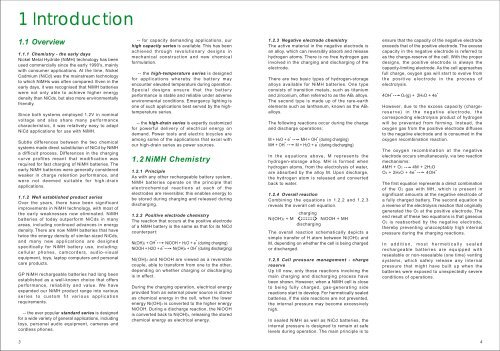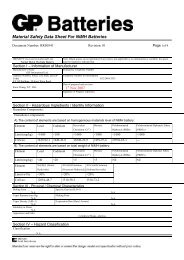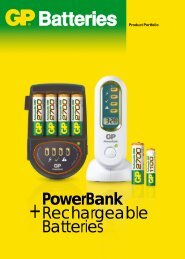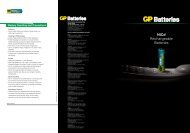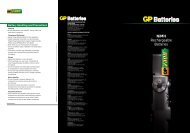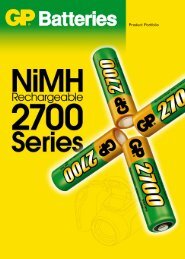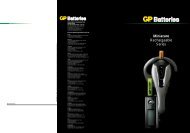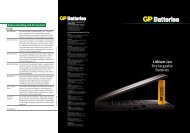Nickel Metal Hydride Technical Handbook - Gold Peak Industries
Nickel Metal Hydride Technical Handbook - Gold Peak Industries
Nickel Metal Hydride Technical Handbook - Gold Peak Industries
- No tags were found...
You also want an ePaper? Increase the reach of your titles
YUMPU automatically turns print PDFs into web optimized ePapers that Google loves.
1 Introduction1.1 Overview1.1.1 Chemistry - the early days<strong>Nickel</strong> <strong>Metal</strong> <strong>Hydride</strong> (NiMH) technology has beenused commercially since the early 1990's, mainlywith consumer applications. At the time, <strong>Nickel</strong>Cadmium (NiCd) was the mainstream technologyto which NiMHs was often compared. Even in theearly days, it was recognised that NiMH batterieswere not only able to achieve higher energydensity than NiCds, but also more environmentallyfriendly.Since both systems employed 1.2V in nominalvoltage and also share many performancecharacteristics, it was relatively easy to adaptNiCd applications for use with NiMH.Subtle differences between the two chemicalsystems made direct substitution of NiCd by NiMHa difficult process. Differences in the chargingcurve profiles meant that modification wasrequired for fast charging of NiMH batteries. Theearly NiMH batteries were generally consideredweaker in charge retention performance, andwere not deemed suitable for high-drainapplications.1.1.2 Well established product seriesOver the years, there have been significantimprovements in NiMH technology, with most ofthe early weaknesses now eliminated. NiMHbatteries of today outperform NiCds in manyareas, including continued advances in energydensity. There are now NiMH batteries that havetwice the energy density of similar-sized NiCds,and many new applications are designedspecifically for NiMH battery use, including:cellular phones, camcorders, audio-visualequipment, toys, laptop computers and personalcare products.GP NiMH rechargeable batteries had long beenestablished as a well-known choice that offersperformance, reliability and value. We haveexpanded our NiMH product range into variousseries to custom fit various applicationrequirements.-- the ever popular standard series is designedfor a wide variety of general applications, includingtoys, personal audio equipment, cameras andcordless phones.-- for capacity demanding applications, ourhigh capacity series is available. This has beenachieved through revolutionary designs inmechanical construction and new chemicalformulation.-- the high-temperature series is designedfor applications whereby the battery mayencounter elevated temperature during operation.Special designs ensure that the batteryperformance is stable and reliable under adverseenvironmental conditions. Emergency lighting isone of such applications best served by the hightemperatureseries.-- the high-drain series is expertly customizedfor powerful delivery of electrical energy ondemand. Power tools and electric bicycles areamong some of the applications that excel withour high-drain series as power sources.1.2NiMH Chemistry1.2.1 PrincipleAs with any other rechargeable battery system,NiMH batteries operate on the principle thatelectrochemical reactions at each of theelectrodes are reversible; this enables energy tobe stored during charging and released duringdischarging.1.2.2 Positive electrode chemistryThe reaction that occurs at the positive electrodeof a NiMH battery is the same as that for its NiCdcounterpart:Ni(OH)2 + OH - NiOOH + H2O + e - (during charging)NiOOH + H2O + e - Ni(OH)2 + OH - (during discharging)Ni(OH)2 and NiOOH are viewed as a reversiblecouple, able to transform from one to the other,depending on whether charging or dischargingis in effect.During the charging operation, electrical energyprovided from an external power source is storedas chemical energy in the cell, when the lowerenergy Ni(OH)2 is converted to the higher energyNiOOH. During a discharge reaction, the NiOOHis converted back to Ni(OH)2, releasing the storedchemical energy as electrical energy.1.2.3 Negative electrode chemistryThe active material in the negative electrode isan alloy, which can reversibly absorb and releasehydrogen atoms. There is no free hydrogen gasinvolved in the charging and discharging of theelectrode.There are two basic types of hydrogen-storagealloys available for NiMH batteries. One typeconsists of transition metals, such as titaniumand zirconium, often referred to as the AB2 alloys.The second type is made up of the rare-earthelements such as lanthanum, known as the AB5alloys.The following reactions occur during the chargeand discharge operations:M + H2O + e -MH + OH -MH + OH - (during charging)M + H2O + e - (during discharging)In the equations above, M represents thehydrogen-storage alloy. MH is formed whenhydrogen atoms, from the electrolysis of water,are absorbed by the alloy M. Upon discharge,the hydrogen atom is released and convertedback to water.1.2.4 Overall reactionCombining the equations in 1.2.2 and 1.2.3reveals the overall cell equation.chargingNi(OH)2 + MNiOOH + MHdischargingThe overall reaction schematically depicts asimple transfer of H atom between Ni(OH)2 andM, depending on whether the cell is being chargedor discharged.1.2.5 Cell pressure management - chargereserveUp till now, only those reactions involving themain charging and discharging process havebeen shown. However, when a NiMH cell is closeto being fully charged, gas-generating sidereactions start to develop. For hermetically sealedbatteries, if the side reactions are not prevented,the internal pressure may become excessivelyhigh.In sealed NiMH as well as NiCd batteries, theinternal pressure is designed to remain at safelevels during operation. The main principle is toensure that the capacity of the negative electrodeexceeds that of the positive electrode. The excesscapacity in the negative electrode is referred toas the charge-reserve of the cell. With the properdesigns, the positive electrode is always thecapacity-limiting electrode. As the cell approachesfull charge, oxygen gas will start to evolve fromthe positive electrode in the process ofelectrolysis.4OH - O2(g) + 2H2O + 4e -However, due to the excess capacity (chargereserve)in the negative electrode, thecorresponding electrolysis product of hydrogenwill be prevented from forming. Instead, theoxygen gas from the positive electrode diffusesto the negative electrode and is consumed in theoxygen recombination reaction.The oxygen recombination at the negativeelectrode occurs simultaneously, via two reactionmechanisms:4MH + O2 4M + 2H2OO2 + 2H2O + 4e - 4OH -The first equation represents a direct combinationof the O2 gas with MH, which is present insignificant amounts at the negative electrode ofa fully charged battery. The second equation isa reverse of the electrolysis reaction that originallygenerated the O2 at the positive electrode. Theend result of these two equations is that gaseousO2 is reabsorbed by the negative electrode,thereby preventing unacceptably high internalpressure during the charging reactions.In addition, most hermetically sealedrechargeable batteries are equipped withresealable or non-resealable (one time) ventingsystems, which safely release any internalpressure that might have built up when thebatteries were exposed to unexpectedly severeconditions of operations.3 4


